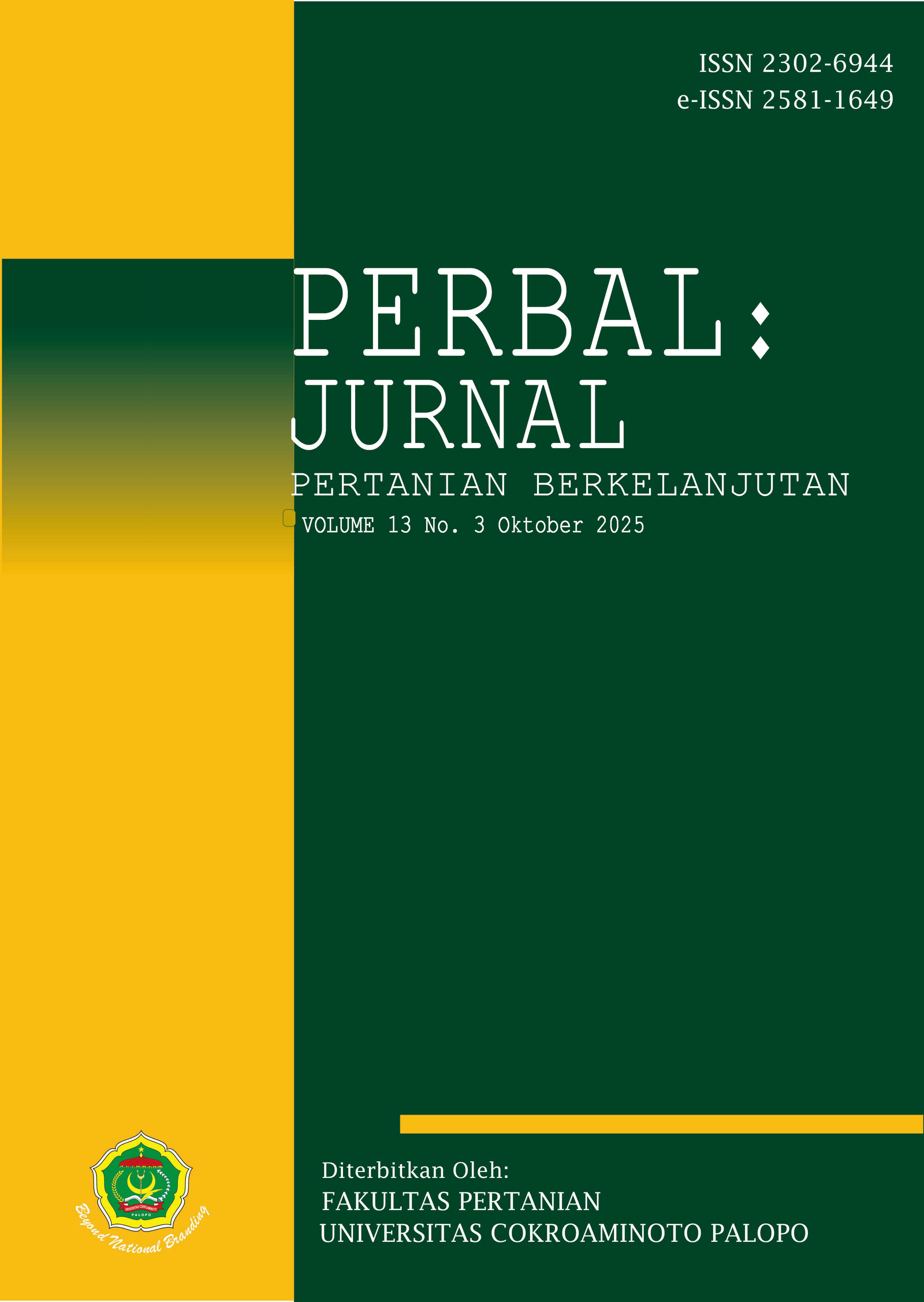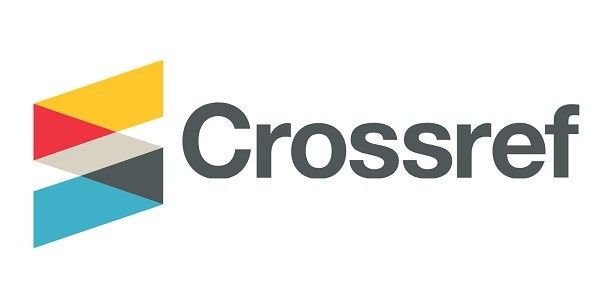Peranan Pupuk Nitrogen dan Co-Kompos Biochar pada Budidaya Padi Sistem Salibu di Tanah Aluvial
The Role of Nitrogen Fertilizer and Biochar Co-Compost in Rice Cultivation Salibu System in Alluvial Soil
DOI:
https://doi.org/10.30605/perbal.v13i3.7023Keywords:
Sistem salibu, pupuk N, co-kompos biochar, produktivitas padiAbstract
Penelitian ini bertujuan mengevaluasi peran pupuk Nitrogen (N), co-kompos biochar, serta interaksinya terhadap pertumbuhan dan hasil padi pada sistem tanam Salibu dengan menggunakan Rancangan Petak Terpisah (Split Plot Design). Perlakuan utama terdiri atas empat taraf dosis pupuk N (0, 100, 200, dan 300 kg/ha), sedangkan anak petak merupakan pemberian co-kompos biochar dengan empat kombinasi (0%, 25%:75%, 50%:50%, dan 75%:25%). Hasil penelitian menunjukkan bahwa kombinasi pupuk N 300 kg/ha dan co-kompos biochar 75%:25% memberikan hasil gabah tertinggi, yaitu 3,92–3,96 ton/ha. Sementara itu, kombinasi pupuk N 100–300 kg/ha dengan co-kompos biochar 50%:50% dan 75%:25% menghasilkan hasil gabah yang relatif setara. Hasil analisis usahatani mengungkapkan bahwa perlakuan pupuk N 100 kg/ha dengan co-kompos biochar 50%:50% merupakan kombinasi paling efisien, menghasilkan 3,22 ton/ha gabah dengan nilai B/C ratio 2,78, serta memberikan efisiensi biaya usahatani masing-masing Rp 5.434.500 untuk pupuk N 100 kg/ha dan Rp 2.833.000 untuk co-kompos biochar 50%:50%. Berdasarkan temuan ini, kombinasi tersebut direkomendasikan sebagai strategi untuk meningkatkan produktivitas sekaligus efisiensi biaya pada budidaya padi sistem Salibu.
This study aimed to evaluate the effects of Nitrogen (N) fertilizer, biochar co-compost, and their interactions on the growth and yield of rice under the Salibu planting system using a Split Plot Design. The main plots consisted of four N fertilizer rates (0, 100, 200, and 300 kg/ha), while the subplots comprised four levels of biochar co-compost (0%, 25%:75%, 50%:50%, and 75%:25%). Results showed that the combination of 300 kg/ha N fertilizer with 75%:25% biochar co-compost produced the highest grain yield (3.92–3.96 t/ha), whereas N fertilizer rates of 100–300 kg/ha combined with 50%:50% and 75%:25% biochar co-compost resulted in statistically similar grain yields. Farm business analysis revealed that 100 kg/ha N fertilizer combined with 50%:50% biochar co-compost was the most cost-efficient treatment, yielding 3.22 t/ha of rice with a B/C ratio of 2.78 and achieving production cost efficiencies of Rp 5,434,500 for N fertilizer and Rp 2,833,000 for biochar co-compost. These findings suggest that this combination is the most recommended strategy for improving productivity and economic efficiency in Salibu rice cultivation.
Downloads
References
Abu, R.L.A., Basri, Z. & Made, U. (2017). Respon pertumbuhan dan hasil tanaman padi (Oryza sativa L.) terhadap kebutuhan nitrogen menggunakan bagan warna daun. Jurnal Agroland, 24(2), 119 – 127.
Adinata, K. (2004). Pertumbuhan Vegetatif Tanaman Jagung (Zea may L.) yang Diberi Kombinasi Zeolite dan Pupuk Nitrogen di Lahan Pasir Pantai. Yogyakarta. 62 hal.
Antonangelo, J.A., Zhang, H., Sun, X., & Kumar, A. (2019). Physicochemical properties and morphology of biochars as affected by feedstock sources and pyrolysis temperatures. Biochar, 1, 325-336. DOI: https://doi.org/10.1007/s42773-019-00028-z
Archanjo, B.S., Mendoza, E., Albu, M., Mitchell, D.R.G., Hagemann, N., Mayrhofer, C., Mai, T.L.A, Weng, Z., Kappler, A., Behrens, S., Munroe, P., Achete, C.A., Donne, S., Araujo, J.R., van Zwieten, L., Horvat, J., Enders, A. & Joseph, S. (2017). Nanoscale analyses of the surface structure and composition of biochars extracted from field trials or after co-composting using advanced analytical electron microscopy. Geoderma, 294(1), 70–79. DOI: https://doi.org/10.1016/j.geoderma.2017.01.037
Badan Pusat Statistik Kalimantan Barat. (2023). Kalimantan Barat dalam Angka 2018-2022. Badan Pusat Statistik Kalimantan Barat.
Badan Pengkajian Teknologi Pertanian (BPTP) Jawa Barat. (2017). Keragaan Budidaya Padi Salibu di Kabupaten Sumedang. Buletin Hasil Kajian, 7(7), 32.
Budiastuti, S. (2000). Penggunaan triakontanol dan jarak tanam pada tanaman kacang hijau (Phaseolus radiatus L.). Jurnal Penelitian Agronomi (Agrosains), 2(2), 59-63.
Casini, D., Barsali, T., Rizzo, A.M. & Chiaramonti, D. (2021). Production and characterization of co-composted biochar and digestate from biomass anaerobic digestion. iBiomasas Conv and Bio, 11, 2271–2279. DOI: https://doi.org/10.1007/s13399-019-00482-6
Erdiman. (2012). Teknologi Salibu Meningkatkan Produktivitas Lahan dan Pendapatan Petani. Balai Pengkajian Teknologi Pertanian (BPTP) Sumtera Barat.
Herman, W., & Resigia, E. (2018). Pemanfaatan biochar sekam dan kompos jerami padi terhadap pertumbuhan dan produksi padi (Oryza sativa) pada tanah ordo ultisol. Jurnal Ilmiah Pertanian, 15(1), 42–50. DOI: https://doi.org/10.31849/jip.v15i1.1487
Hickman, J.S. & David, A.W. (1990). Soil Conditioners. Departemen of Agronomy Kansas State University. North Central Regional Extension Publication 295.
Idwar, & Haryanto, S. (2015). Respon berbagai varietas padi sawah (Oryza sativa L.) yang ditanam dengan pendekatan teknik budidaya jajar legowo dan sistem tegel. Jurnal Online Mahasiswa Faperta Universitas Riau. 2(2), 1 – 15.
Jumini, E., Siregar, H.H., & Aini, N. (2011). Efek kombinasi dosis pupuk npk dan cara pemupukan terhadap pertumbuhan dan hasil jagung manis. Jurnal Floratek, 6, 165-170.
Kresnatita, S., Koesriharti, & Santoso, M. (2013). Pengaruh Rabuk Organik Terhadap Pertumbuhan dan Hasil Tanaman Jagung Manis. Indonesian Green Technology Journal, 2(2), 2338-1787.
Lehmann, J. (2007). Bioenergy in the black frontiers in ecology and the environment. Ecological Society of America, 5(5), 381-387. DOI: https://doi.org/10.1890/1540-9295(2007)5[381:BITB]2.0.CO;2
Makarim, A.K. & Ikhwani. (2012). Teknik Ubinan, Pendugaan Produktivitas Padi Menurut Sistem Tanam. Puslitbangtan. 44p.
Marsono & Sigit, P. (2001). Pupuk, Akar, Jenis dan Aplikasi. Penebar Swadaya. Jakarta.
Novriani. (2011). Peranan rhizobium dalam meningkatkan ketersediaan nitrogen bagi tanaman kedelai. Jurnal Agronobis, 3(5), 35-42.
Novizan. (2002). Petunjuk Pemupukan yang Efektif. Agromedia Pustaka. Jakarta.
Nurida, N.L., Achmad, R., & Sutono, S. (2015). Biochar Pembenah Tanah yang Potensil. IAARD Press. Jakarta.
Ofori, J., Anning, D.K. & Narh, S. (2019). Improving rice growth and yield through integrated compost and urea fertilizer application in lowland rice. Journal of Ghana Science Association, 18, 1-7.
Prada, G. (2015). Filoremediasi Tanah Tercemar Logam Besi (Fe) dan Kobalt (Co) Dengan Tanaman Akar Wangi (Vetiveria zizanioides) pada Media Tanah Berkompos. Program Studi Teknik Lingkungan. Fakultas Teknik. Universitas Hasanudin, Makasar.
Rosmarkam & Yuwono, W. (2002). Ilmu Kesuburan Tanah. Penerbit Kanisius. Yogyakarta.
Setyorini, D. (2006). Kompos. Departemen Pertanian. Balittanah.go.id.
Sitompul, M & Guritno, B. (1995). Analisis Pertumbuhan Tanaman. Gadjah Mada University Press. Yogyakarta.
Sugito, Y. (2013). Metodologi Penelitian; Metode Penelitian dan Penulisan Karya Ilmiah. Cetakan Ketiga. UB Press. Malang.
Downloads
Published
Issue
Section
License
Copyright (c) 2025 I Gede Megantara

This work is licensed under a Creative Commons Attribution 4.0 International License.
In submitting the manuscript to the journal, the authors certify that:
- They are authorized by their co-authors to enter into these arrangements.
- The work described has not been formally published before, except in the form of an abstract or as part of a published lecture, review, thesis, or overlay journal.
- That it is not under consideration for publication elsewhere,
- That its publication has been approved by all the author(s) and by the responsible authorities – tacitly or explicitly – of the institutes where the work has been carried out.
- They secure the right to reproduce any material that has already been published or copyrighted elsewhere.
- They agree to the following license and copyright agreement.
License and Copyright Agreement
Authors who publish with Onoma Journal: Education, Languages??, and Literature agree to the following terms:
- Authors retain copyright and grant the journal right of first publication with the work simultaneously licensed under Creative Commons Attribution License (CC BY 4.0) that allows others to share the work with an acknowledgment of the work's authorship and initial publication in this journal.
- Authors are able to enter into separate, additional contractual arrangements for the non-exclusive distribution of the journal's published version of the work (e.g., post it to an institutional repository or publish it in a book), with an acknowledgment of its initial publication in this journal.
- Authors are permitted and encouraged to post their work online (e.g., in institutional repositories or on their website) prior to and during the submission process, as it can lead to productive exchanges, as well as earlier and greater citation of published work.














